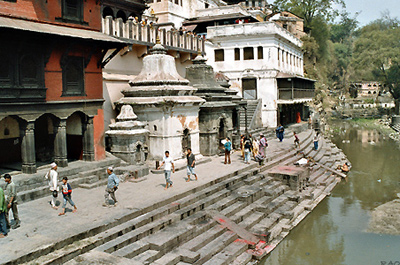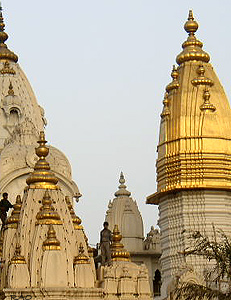|
Hindu
beliefs and practices
Categorizing
the religion of Hinduism is somewhat confusing:
Hinduism
has commonly been viewed in the west as a polytheistic religion - one which
worships multiple deities: gods and goddesses. Some have viewed it as a
monotheistic religion, because it recognizes only one supreme God: the
panentheistic principle of Brahman, that all reality is a unity. The entire
universe is seen as one divine entity who is simultaneously at one
with the universe and who transcends it as well.
Some
view Hinduism as Trinitarian because Brahman is simultaneously visualized
as a triad:
|
Brahma the Creator who is continuing to create new realities |
|
Vishnu,
(Krishna) the Preserver, who preserves these new creations. Whenever dharma
(eternal order, righteousness, religion, law and duty) is threatened, Vishnu
travels from heaven to earth in one of ten incarnations. |
|
Shiva,
the Destroyer, is at times coMapssionate, erotic and destructive. |
|
 |
|
Shiva
|
|
|
Strictly
speaking, Hinduism is a henotheistic religion - a religion which recognizes
a single deity, but which recognizes other gods and goddesses as facets
or manifestations or aspects of that supreme God.
Most
urban Hindus follow one of two major divisions within Hinduism:
| Vaishnavaism:
which generally regards Vishnu as the ultimate deity |
| Shivaism:
which generally regards Shiva as the ultimate deity. |
|
 |
Many
rural Hindus worship their own village goddess or an earth goddess. She
is believed to rule over fertility and disease - and thus over life and
death. The priesthood is less important in rural Hinduism: non-Brahmins
and non-priests often carry out ritual and prayer there.
Hindus
believe in the repetitious Transmigration of the Soul. This is the transfer
of one's soul after death into another body. This produces a continuing
cycle of birth, life, death and rebirth through their many lifetimes. |
|
It
is called samsara. Karma is the accumulated sum of ones good and bad deeds.
Karma determines how you will live your next life. Through pure acts, thoughts
and devotion, one can be reborn at a higher level. Eventually, one can
escape samsara and achieve enlightenment.
Bad
deeds can cause a person to be reborn as a lower level, or even as an animal.
The unequal distribution of wealth, prestige, suffering are thus seen as
natural consequences for one's previous acts, both in this life and in
previous lives.
Hindus
organize their lives around certain activities or "purusharthas." These
are called the "four aims of Hinduism," or "the doctrine of the fourfold
end of life."
The
three goals of the "pravritti," those who are in the world, are:
|
dharma:
righteousness in their religious life. This is the most important of the
three. |
|
artha:
success in their economic life; material prosperity. |
|
kama:
gratification of the senses; pleasure; sensual, sexual, and mental
enjoyment. |
|
The
main goal for the "nivritti," those who renounce the world, is:
|
moksa:
Liberation from "samsara," the This is considered the supreme end
of mankind.
|
|
Meditation
is often practiced, with Yoga being the most common. Other activities include
daily devotions, public rituals, and puja, a ceremonial dinner for a God.
Hinduism
has a deserved reputation of being highly tolerant of other religions.
Hindus have a saying: "Ekam Sataha Vipraha Bahudha Vadanti," which may
be translated: "The truth is One, but different
Sages call it by Different Names"
|






